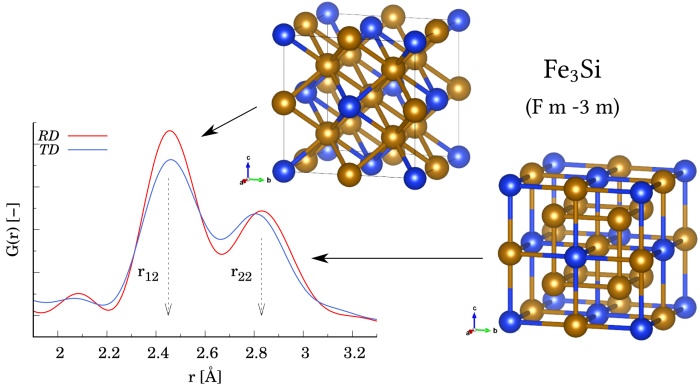Speaker
Description
Many technological applications require low permeability of a few hundreds being constant over a wide magnetic field range. For example, this is a case of magnetic energy storage cores [1]. It is well known that magnetic anisotropy induced by stress applied during annealing can reach magnitudes up to several thousands of J/m$^{3}$ which is about two orders of magnitude larger than the magnetic anisotropy induced by annealing in a magnetic field [2]. Furthermore, stress induced anisotropy (SIA) represents an effective way to tailor magnetic characteristics of nanocrystalline Vitroperm-like alloy systems. It was shown that the SIA has its origin in magneto-elastic anisotropy of the Fe-Si crystallites associated with their elongation induced by stress annealing [3]. Our recent results obtained by mapping out the strain pole figures (SPF) corresponding to several Bragg reflections of Fe$_{3}$Si cubic phase show that SIA is actually uniaxial and its main axis is aligned along tensile direction. Furthermore, SPFs provided evidence that strain partitioning among different Bragg reflections is not even and the magnitude of the SIA for a given set of Bragg reflections $\{hkl\}$ is inversely proportional to its Young’s modulus $E_{hkl}$.
The main goal of this study was to analyze the impact of the SIA on a local atomic structure of Fe$_{3}$Si nanocrystals. High-Resolution Transmission Electron Microscopy (HR-TEM) combined with Pair Distribution Function (PDF) technique were employed to address such a delicate topic. As can be seen from Fig.1, PDF provided evidence that the bond length distributions corresponding to the nearest-neighbors environments of Fe$_{3}$Si cubic phase are reflecting direction of applied tensile stress. When observing PDF along tensile direction, shifts towards larger $r$-values are observed for all coordination shells up to 20 A. An opposite behavior is seen in transversal direction. HR-TEM analysis of several individual grains having different crystallographic orientations reveals different extent of change in interplanar spacings depending on Fe$_{3}$Si crystal orientation with respect to direction of applied stress.

Fig. 1 The first coordination shell as seen by pair distribution function $G(r)$ measured along tensile (rolling) and transversal direction, RD and TD, respectively. Well-resolved sub-shells located at $r_{12}$ and $r_{22}$ refer to bond length distributions centered around 0.245 and 0.283 nm, respectively. These sub-shell peaks correspond to the nearest-neighbors environments of Fe$_{3}$Si cubic phase, as depicted in the figure. Fe and Si atoms are depicted with gold and blue colors, respectively.
Acknowledgements
Vitroperm-800 alloy in the form of thin ribbon was kindly provided by Dr. G. Herzer from VACUUMSCHMELZE GmbH Hanau, Germany. This research was financially supported by a Slovak Scientific Grant Agency VEGA (project No. VEGA 1/0638/24).
References
[1] H. Fukunaga, N. Furukawa, H. Tanaka, and M. Nakano, “Nanostructured soft magnetic material with low loss and low permeability,” Journal of Applied Physics, vol. 87, no. 9. AIP Publishing, pp. 7103–7105, May 01, 2000. doi: 10.1063/1.372944.
[2] G. Herzer, V. Budinsky, and C. Polak, “Magnetic properties of nanocrystalline FeCuNbSiB with huge creep induced anisotropy,” Journal of Physics: Conference Series, vol. 266. IOP Publishing, p. 012010, Jan. 01, 2011. doi: 10.1088/1742-6596/266/1/012010.
[3] M. Ohnuma, K. Hono, T. Yanai, M. Nakano, H. Fukunaga, and Y. Yoshizawa, “Origin of the magnetic anisotropy induced by stress annealing in Fe-based nanocrystalline alloy,” Applied Physics Letters, vol. 86, no. 15. AIP Publishing, Apr. 08, 2005. doi: 10.1063/1.1901807.
[4] D. Yudina, M. Marsilius, and J. Bednarcik, “Structural aspects of stress-induced magnetic anisotropy in Fe-based nanocrystalline alloy,” Journal of Alloys and Compounds, vol. 960. Elsevier BV, p. 171011, Oct. 2023. doi: 10.1016/j.jallcom.2023.171011.

